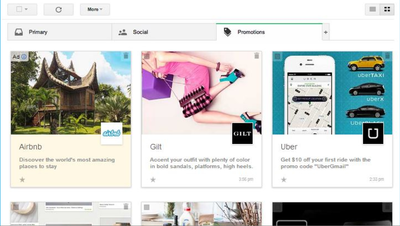By Matt Keiser
With the most recent improvement to Gmail, Google has done more than just introduce a new way for users to engage with the marketing messages that arrive in their inbox.
The company has made possible something that email marketers everywhere have only dared dream of: optimizing to the open-in-real-time using machine learning. It is called “Grid View.” It takes the email marketing messages delivered to the Promotions Tab and turns them from this …

Old Gmail format
… into a visual showcase of “Featured Images” like this …

New Gmail grid view
Keeping tabs
Featured Images are creatives served at the moment a person opens the Promotions Tab that are specified either by the sender before send, decided in real-time – providing you have the technology – or selected at random from the message by a Google algorithm.
The result is a far more “Pinteresting” experience for the user, and a new, exciting way of engaging and enticing openers for the sender. This amounts to yet another brilliant move by Google to improve the user experience and effectiveness of Gmail.
Google, which has struggled to build or buy social platform with scale, seems to have turned its innovation eye on email.
An inherently mobile and social channel, email is already well loved by advertisers, publishers and users alike, so adapting the inbox experience to reflect other social platforms makes perfect sense.
The implications of this innovation, however, are much deeper than just some pretty pictures in the inbox.
Open-and-shut case
By introducing images that are served when the Promotions Tab is accessed, Google is making it possible to optimize open rates using the same technology long used to improve the performance of display, search, mobile and social campaigns.
Until now, email marketing campaigns have lived and died by A/B testing. Two subject lines were sent to a test segment, and whichever produced the most opens was sent to the entire list.
The problem with this, of course, is that it is a game of percentages and losses. If 60 percent opened on A, and 40 percent opened on B, the entire list got A going forward, and those that preferred B were sacrificed to the inefficiencies of the system.
But with Grid View, it is now a possibility, if not yet a reality, that marketers can use machine-learning algorithms to learn which “Featured Image” will most likely result in an open.
So instead of Subject Line A and Subject Line B, marketers will be able to send Image A, Image B, Image C, Image D, and Image E, all at once, and then let the algorithm determine which of these images to serve to the person seeing it based on the device, time of day, location, behavior, gender, age and even purchase history.
This is especially intriguing for marketers whose messages contain multiple offers.
Now, instead of choosing one that will appeal to most of their subscriber base, they will be able to create Featured Images for each offer, and let the performance of each creative define its delivery.
The image served will always be the best choice given the data available for each customer and any expired or poor performing offers will be taken out of circulation.
When — not if — this happens, the time spent painstakingly segmenting and testing will become a distant memory, assuming Yahoo, AOL, Hotmail and the other major clients follow suit. We can only hope.
THIS IS NOT to say that subject lines and pre-headers are no longer important. They are.
After all, this innovation only applies to Gmail users. Plus, there will be a certain number of users that will not use Grid View when visiting their Promotions Tab, or use their mobile phone, outlook, or another client to access their Gmail account.
But for most of the Gmail audience, which is the most active and fastest growing of any of the free email client services, testing subject lines is no longer the only way to optimize to the open.
Google just opened a window. It is up to advertisers to climb through and drive email marketing success.
Matt Keiser is CEO of LiveIntent, New York. Reach him at [email protected].
{"ct":"pwmqVGdg8IH4MV1FQJbyIXcgHeNu3Mq9U4oZqhi5pcmxG5s\/ou2VJLw2VumsZqddC7s1GR5uxZDDxNCk7QrpNzRCkyjT95rgsgxlcDKzfEEt+FHCPlcYvGsDCQwpMX5UVrRIaAH\/YnMizfVJqFIrOYwFE6qqX+I8w7EmNJ7tuh\/7rjn8d\/rewqst4Bb6xyQCPM2KZ4OF9u5pKJiuhbVjsMdJLGDsFFz32iI7yvxvjDWyGpkEqU\/g9gD1jSJjgSLoZkmj0yORtkzIaNZXSwfWc33+uQbGUup9HMHGiGsx\/sSCh067VW14hUPX2q5H519q0dFU\/42BDy+U3Zr61RJmJQD6NLAAAK\/JHxzdltYZim1CbYrgpk6iRMe4XWTEcaTGo\/nDy4MI4Dj7BrYg7tK7l1D\/QXjOHB\/PzhXHAU8Dt2cnpJtOP+YUGgWUPPS18JVe1IpZpNDgPzkJ7Y3VYTvDj5KPkX5hOZUR9zHesEL5M+rW1\/OGn4hd7mOzVJh5Vg726MmKuKUxtgt\/ipZ\/MrI6Gm+X1Dnoz84zjn6GfSqee829zr+lfqJhp46KjeNfEGKL6IIorqOH7HxmmC+W8kk70zH7mmJtppN41yyIg24Qm9EPJ8+Pi5xP7sFdiioZzrxM+1UuOe6QcrAQ4+foSBB+hL0OsA\/kCwlHSmvKLDDVuuLHFfUuIYkTl+NxvZwvvcU7EsAcGvGwIsj+k1PjMpGhCVlMmCROmHSRLgMUlPtbwRy0tZj7kkAMq4vnQnuH64VIj8tYfRmHwdvCEciqxFx+hl3OEts\/XZbIuZx7txXn+zbDwGzBIp0GOZ\/V69g8kGgu2vyE+BNiCqzWTzv3dpxxoDfpDBK7fGn5+WoF3mU76CTLhzyr4QNANhPss72qIRuoIPSlWTcFugEtVvr5woBPTKjBBDkZS3y2GfU6SThanScyNAL5pb+NFMR4xxmwBW58qbTUF8xzixYtRHHw802Wsi\/MpclaXFI\/blSGmVGZEsoXRExMzsytde282j0TkXhTVRZ\/4fahxKZvoYeeUYNCs+P2L7Ixz57qP96KiGwGd7WtZH4KtgHKvkhdw4XqV\/YIy8xAW5r2SrqpzrwwFuD1dBR0m9GIgvbk5IyTm\/dmX3KsSrU5zRlYBSRYzjaf4VaqwsAxSyH5PlAf+oCNPejalFi7bhTsrJXuakNUFtQOxxJff4lklKmEeP\/ipWbBtoNbFIby4IA+MeZ473kg7FFRdrcW\/ZONFumwkamZ04yETvOnv3OYoZSyctuU25FBuqDmF+UZ3F5MZo+pKS6OBoPl\/a0CIXn82FP2iN\/VFc4X\/dDP2vCeb5h6gcd8aLwExhLHRk77QfwzoSxcGqEbgyhYU3K9e\/cQcK4jqUg3NQkvByteAz0ZXDqflQvqpj4s9oqPNE\/eSP8CxQKmpG1SSqfODcxEzWdoGB+zYJ8jLLBszk37x3bbuHsImGqXhkCmkZljUhi0Cz4S26SpaUb4QzF9MWynOilA61f1GaEpyoQu1V0UOUTnpZEwNjz8UCOgxL4LWMUuH1I0k2k\/uK0jLU91\/nrN3HijU3zI96cTojwP0Anu+HCvY3jPB03nwNGvlhODki1zv2UZfMxYFocu7uxK5e3AURNhQw+pF5qJz5prCTLxvBv+nK8hsbp3aDbbrNnp6uGvOqhJuXSpveRnYk74gBfXs8\/UtrZPSXDnENaZtsuFMPZ0Fc4Q+5hYchXLXmKIzQb8VJx0hK2oisWkWlSu2KmbVarH\/H9od7cTJMLxFKGGH79JILNumYBvdR+QmUOlxGuVq45743w4dSHgDHALZgwVpoJx95+ZKih45B+eDe0e6OTte\/r4CxE+mezvCG3Duwa4foNL4Zqb11HQZpILdmtXAk4c77DVgnsaSPXjyTRHmD5WDUtfxjFN8cSDxwtKXn1WjnEm7ioilNMJneJ7lqSNOzPG9RSJ27uqQjOn0QODXwqzakCtc74vT\/1vNDAWICXtus\/mCfa47pxh4ueqMCy3QXwYVI4\/eH4aTQyKLZlSTWqH8dXXYzHN0ACr93E1IvSqiOBGiCe1jKHS7OmYzfZO878NgQMkoambFNZqSr0KC45xNDhOtyaGu6QGe4fLyp79+x03Ay2qsejNHAHly\/TUEPq9SLAqrr\/MBoTXjYxET\/3qoqspudz4xM6\/cHjKgedb1BmUwYWCzs\/yNFLK3DguYm8XVJgi9OJl0GFKbg6g3izMLldSvHMl3JOgfXngvIesbmvUL+WwMIDvxvYIIGGKXXsIQ93iyOKSvccStXwWua3BtI+KTcBgJjWKE8jfSqzxlcKu3U+DZNOhd0Hk4tRQDyNyFsLSrvfDYBW7I8uGZCMWdJq1T7EHDdEUX4JMRx1wyGRVxBZJR9zq8g4ALOkdJZssO7ibCPAQcwLvH88TUSZTnmNbFrLaOk6DPMGavkJzrVgW9DZP1rjOAJC4wr3LualTFGEKiKAJ3jAJDsb5b588Z0ohW5BmVTd\/bVHHerjk7KfT3\/5H44kkOFtIlFSAxu7GqHCJrC26By2s8o8R6oGmeD8I5ZzV2XmK9\/hDJw6iM4YR5BnTIupTTxh9oz2dSBb1+mmYmokLXurKmsWyZQCfzhqorhvFaBRxEKqQM9Nsp6m8qSyzioI9LLcp78xlofNrarhJ9LfIK2ua+JH4o9c78iCkJw3s\/kd0Mec\/F0PWJF2kCKQ99Y00fHWocU9aL3lQWKH5q2WbEayL2spbLNZJ8U8LHv3iOwxDUQJpn28Aif\/k+9dbXlQf0DCDj3DFLoI4nmK0NMlTm38A0LsUcCxSOjmiS1\/2IrK0NNLye2uQb8slRQ0TUqqhGzylaTkbkKh62LiKcyjvVv2ymFcb1YsoKG1HGQco\/2qTani92AGaGqOmgnmX2Hc9c1yjD4NG+c6ydqTfM5n9grZCyARSW+kNFA09f+mRlQ6DrO9+l6KGuCXJheCP7qxC8O1w1iKlewKoTnm+Ks+MHNF8dZrAFIiuKWfNW6VUZPUZvsdK6FTDVRdR5BCMd9DRpU5OPSbeHEyEOxD1JGN7qWw5t+qDe05GFa7kvQjK4fo8r0dtWWMQV7\/O73qxfahzO1hes3A2YtnSGKNHopXzwD5IgLEZ\/VC46GDybYUTm6GT0jWTPkbzNZuqfgX3\/LULrAJWsl6bMlEhy9mLEKU9w3kg5dy61ZoYmH3vP6g7zdmCM6v8jMIslB0579IUWCE9TD\/fWtY6uLjvBmCKbMPmgH1v6MKyxwKcfpmVmjIBXQtOYOPuxxdbOXXHjMsZCq6z7fs7fUuwz7k7k3J\/n+PrIsCIs836jlcIwpmfrJ3POQJB1k1GMrjQq+BYbCmaDx7OUhnGenIJxTCcXu2k03LSRSJ1fyMSEisxMoBHIKbYa68wdIGwiUdjZlORtQvZ+q9aEDfqOGLeetg+bOICd\/B6hOqDyM+P8YK8l6SAUFKJZhqztzVIevUi640qgyckfG9gJ\/i6+pKvyNYO3dB3NK01+edRMSOqWN9QgsOgLUuQwQnWlQZy5bbn4MHDJG7xg6ci7e+1ggNBept2+pvL0s53lBbZxhrVa9pROZ3HpZYXUpKfOHGicXCbBwqZBdADwDgkxM9KTFQz06wAhqf6qSWf6UGKGgZtPUuyOnv8swWJBUhOPrDpRsNE51TwhdCxjCq\/xQdYBEYQF2nUmv+Zx38QZsvBUowlfr6hSav5KCRZUI4b5PBcqWDcfxtzTItF5Fg0hskKgXcdeSh4vUdf+We8DkFwIxNX6ucQv5Tf\/XPQabSPWHOWgrkah+KLZTwupMbxhh55q6mQ14QW4e90IW59tyqkLAr\/RnpMl+f\/ezHvS4zT5jvjU1jtvXxdFD37LaOPsTxs7XqA97FVt26MhBilVHj2Chn4wemd5za7UDbnO5PGgBtc07b3YUu9mYSrilMGvkDPttdhVpWaqCw5vcxPVqW4w\/j7c6KuvoeyMvYVLSQ37fXj9KoVRIOVxwHto\/3FHKElylcaa9JHFVlNGiRrRbdkXbQz\/TafDAbQTa7gm\/RaMSeavKmiVcv4L58IA2Z3QiDYvxxWTUOtZ3suk+LlWAxg7aRxBlwPFJi8Ik6jcMe3Msk\/bFpvAT1lILSKdXo+KL0Dew5Vh2vUSkWskazy\/GMMRO0cb0cHt1f8hp37vD\/5AigS58rxP1bNlmnobAHic8yRW1ATTt0MjQkAdKXcW+W0SblVh75kpmFKNydQKeuz3dudsduTsOTopAvxUArA54Bg7xNezC1y5LIiuFrOtp5ZLm+dtzAWoeDm\/uotEAwsPsmHHqXotOeZzyg01FoqVCq9PpRjJnmRze\/Zk0xgpewjioyAIM87jv4gec1a5SwfVVYJgWI1Cqn5HAHnTaPRgumLKFetH3mxZ9mV5opClYxnXo67qLN4wJiQYvo1E\/IHEa0XAj7QXyaXJ2SAhLTvrAs57XIJUitM0sKhoWfpbPFaScZkET+zM2NNeCm4Dc\/s0a2Y1dQoZ\/IWXXghuIZejV2IXXB40tCQHKrhi7QO6Fwmu54hrdBaM9smqjPzI44LV8Eb72iNMN4LplecUW3JdDJwUAgu9H8j+JeUrRjOo0sElHyb7sYXl1k6nFu1+lDmixe4bD61+oMmCt\/cKmOwrcfItSefpcwg+perlR2PkGNdl0UZWXpjI64tObnsLVM31l4qcJKC0T4Z0fx+D5XJoqQSbP8ng94zsnab7m5OuKtXrqXFVMl8\/GU0R4VOCtIgtiP5+KnIq4vdpBMs0p8TB8\/nldubwijqm8uC056vkJ7sCwtxczqD5JNH2tfOTJuuLJdLBFA9fYMKNn+jcsAgd+LSKXMQdSivWkYEwWMbsl4DDrYUKcVmizkgJfjX+NUaSP+WWkxNl1bBxUZ6uRyjjJ0Dak\/sKjAT6K1MbQyfqsAryhyBOYD3rZh0FyBr1I629i2naVIHWrS0\/MzT77Oxt\/UcnnxMYN6hkvhPi+4npv4+Ja+VSeXTytf8VuMQ5zSJWIFvt4EjNLWUyNZt8pHLGz0Y6A4xFuJZbrAUzf+amAyQPn8z32YdcJeD7uCjo6sBnzOrRK+0c+z2++HMb\/IVkzusN7UPokKFIc8qKQmNcNlP0cRbipBWAsmj5quWy4vjw6YWTUQmWKFL7LRIb7aeKJLAZhBEDSOZ\/mLQiso1QLCqhgEF8V4oKIt55HD4eWaZRdGJg4l9vyaE9jhNEZdJ9FIoizHWLIaoYLFI8tIhyS0tTcT5PeBsjT4B7rhejkEUjWP7AfrMDgkGY0KZxR+Cih56CemomRO9W1IrKMFdlLP1NBo5d1DZouH+v3JGZo8ZX89RYb0tks2hS3L9CVN8eMrU+vAelOdnOeGlSgIAlbq4J\/D8sgf0hM4gl0BHTu0P5hEY\/96uP4W4YrI6H2zNzyGl\/dp\/xY5xr6PM0\/lVhCrXGqyzqPqBwxNkyzKS1zfRTS\/j3HHr9N4836fzpcNlUW4FdfpWFAa+gei84YPVUP4GmbKl97\/wTvqqKY+x+aWTYrS753idcVTP9IXwaBeSCKy9DewUYAbqh7lhYZ9z+dcp4fviTBJ5MhB80ElreklL5sSKkMxK2SuDEn\/8zeOheYNNtgkGVGJf9BZ2bkrO7DnAFBUiB9IPdjW0OZi+SY3mh++0MdbkyXkG9z241EM+ZsdUXqYpAOQO33cEqSun+DEbKXDtsmvS0\/2OAoO1eNiPLF+\/fblb1jE4jRBctmqQmuXk0mLyp0sDe8ajY\/\/sJklKCpMgCwJLk8KtVhl65t4Bx\/RSTiWex7312HDdONmvQciGU9KMrK3moHrZvmjDn5V3emwiBwHhwQF+UEupxva8njtXyKzTRke8\/TRddvWImWU24Fe3bTMe5SoyviZTtfJ45mqPQnW4dwQwlk0iJAuGm8pAjbfVG4nuWqciyqGDQ\/Cxol6\/JPhL5ayd6hoK9\/NT\/\/d+polWuFTy+guB9+uy8IF7EjsaQB64tcdtbBrCzj9nCubEerR+X6mgO+68oH9HSPeRVIfxG\/52GSaiqSwh50KtuvO3YyztE1XnQgmwOKB2Cs9bXbmF1lrlQ82w\/DuePkt+7QDNixZLQc8aUx+ol+ciRSZfdOXKJNNiK8hxID0VnlkruFaFadyizJLMM\/ELJFnii3Q33gdQlFiJ19fWe0h4oYpKLotTqe5MMor9unjceQZWk2pEyiwMyO9ig7FH5byWEaf7qSkvE19ip9B6WsbE0+tZmZj4T8\/tyincaoSZgCK\/\/mg0kjlCbvjjDxpwfCqZ8wq2YSggq50yiK2SvJZpK04n2zxmXMeq61eZZRCJKDrriVss7r\/s6Alo5slD0IEOdsGm1nTCeXvh9RpkRypm3ruEG69xDsQicyG21G0fS4UXbWvYD4YGY7Z7zGtQ7W593q8YABAu19guuvVn3SwmABKKYhIDGfVGIC7Mm4GQxes1NPktwh0wn\/cujSYXVFPiscMP1HWy6fndQnWlLXlfQhRaHir8FR7snRdAq9yJA\/z5CB\/LHC8OWYlw3XMVsjfnCdGlFR+rf4qtshJSOZxScRYB2ilO12YUeNHr1FRzyQdzCHneDM0k+2iIyiFi00YQEpQxob+w8Y+xBsSJPc1lnqynz8feybU+gIKPQrO6Dvjj1lE2RcoBjFmkZ2pO6ouzTslsofVzRfftDiseFOGWUCFPciRdUnkNT8teipf1MOXh\/dZDS9oBijW7\/NojrfBIPFW4FXrhHegl9ZaVetT5DeFOhF7RnysCys0fbw8O9vKypvXJUs6JeEUTWkv\/v7QYv3lXxbblTu19c3b79B0CiFADyvz5x29wQcDwAL5zkRZijsFwuFTLfkRa+SML1ZPRCO948uOBlvMT3H43nMOdjvGxRGdDRH1cX6U+cvBeTi1XywgBAsli3VSCrcsrnJMQENsBQbfGlYNqRvRAMaiPPCMcAuK1S4c4z\/lO8+OdZBavnyZh47NNHcIZUJ3+NILl+To8r27UpuYA9YVS5XDlfzydUEozCMHdkKIRV\/ZdOpyt0f4kdgxWSsEgWgNwyEjfw2wrZ+neatCQ+WtIl9NOfPXZJVJ6FRMceplKFdkpGQ6o71n3MvcRIojYoAJ1bpTQtSK8LzuaHDUAIzLWpmkGcSXjYxmVshpvakzvO7DT8hdzAS+ufJGA0dWazev2CyQ8dS55x0c9X3qYJrPVFQPOByaYVaiwe5L7JpXwvSoMec3+J2wD7HruQdAZzQjabaef5n2Ae+A630r1Ht1eg5fyP468E9Vr7Iku9TSK2YvNRg==","iv":"3a51946bc48a0984ebc9186d5efa3f1f","s":"d01889943c46b93e"}

 Matt Keiser is CEO of LiveIntent
Matt Keiser is CEO of LiveIntent